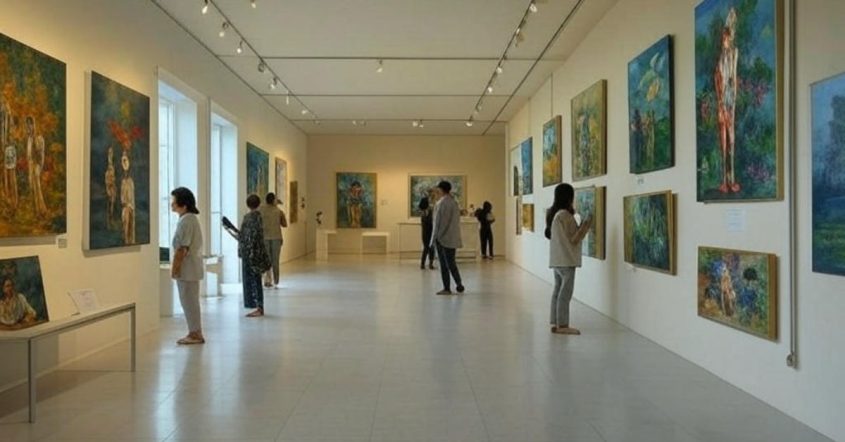Every artist dreams of showing their work to the world. Exhibiting your artwork is a powerful way to gain exposure, build a fan base, and attract buyers. However, traditional galleries often charge rental fees, require commissions, or have strict selection criteria, making them less accessible for emerging or independent artists.
Luckily, you don’t need a large budget to begin exhibiting. There are numerous opportunities to display your work for free—both in your local community and across various online platforms. In this article, we’ll explore a wide range of free exhibition spaces and strategies, so you can take the first step in getting your art out into the world without spending a dime.
Local Venues for Free Art Exhibitions
Community centers and libraries are among the most supportive venues for local artists. They are publicly funded and often encourage cultural engagement. Many of these institutions have walls or rooms featuring rotating art exhibitions, and they are always looking for new artists to showcase.
These venues are generally easy to approach. Visit the center or library, speak with the events coordinator, and ask about available display dates. Some will require a proposal or a portfolio, but most are open to showcasing work from artists at all stages.
Advantages:
- Free, accessible space
- Family-friendly environment with consistent foot traffic
- Ideal for local exposure and networking
Pro Tip: Offer to host an artist talk or a small workshop alongside your exhibition. This can increase your visibility and help the center with educational programming.
Cafés and Restaurants
Displaying art in cafés and restaurants has become increasingly popular. These venues gain stylish decor, and artists get exposure. Many businesses welcome this type of arrangement because it livens up their space and attracts curious customers.
Start by identifying establishments with a creative vibe or those already displaying art. Approach the manager or owner during a quiet time and show a few samples of your work. Be clear that you’re offering your work for display at no charge and that you’re open to rotating pieces.
Advantages:
- Great exposure to diverse patrons
- Flexible and informal display opportunities
- Potential for art sales (include contact info or price tags discreetly)
Pro Tip: Use QR codes linked to your portfolio or social media so viewers can connect with you instantly.
Town Halls and Civic Buildings
Civic spaces like town halls, government buildings, and city’s service offices often feature rotating exhibitions of local talent. Since these venues are public and aim to support community initiatives, many are open to featuring local artists without any fees.
Check the official website of your city or town for art initiatives or contact the local cultural affairs office. You may need to submit a short artist statement and examples of your work.
Advantages:
- Professional setting that boosts your credibility
- Supported by public art programs
- Often promoted through municipal newsletters or websites
Nonprofit Galleries
Nonprofit or cooperative galleries are community-driven and more accessible than commercial ones. These galleries often support emerging and diverse artists and don’t prioritize profit. Some rotate exhibitions monthly and actively seek new artists.
Organizations like Creative 360 and similar regional centers frequently host themed exhibitions, open calls, and group shows. Reach out directly or join their artist mailing list for updates.
Advantages:
- No or low commission structure
- Built-in community of art lovers and supporters
- Opportunities for networking and collaboration
Online Platforms for Virtual Exhibitions
Artavita
Artavita is a free online portfolio site where artists can create profiles and showcase their work. Once your work is uploaded, it becomes discoverable by galleries, curators, and collectors worldwide. This global exposure is valuable, especially for artists without access to physical galleries.
The platform also hosts art contests and virtual exhibitions from time to time, giving users extra visibility. Although basic use is free, they also offer premium upgrades for those who want to explore additional features.
Advantages:
- Free global exposure
- Easy to create a digital portfolio
- Opportunities to connect with art professionals
Artsteps
Artsteps allows you to create a fully immersive, 3D virtual art exhibition. This platform is great if you want to offer viewers a simulated gallery walk-through experience. It’s ideal for sharing on social media, embedding on your website, or emailing to potential buyers.
You can arrange your art in virtual rooms, set the lighting, and even write descriptions or audio commentary. It brings an interactive experience that static websites often lack.
Advantages:
- Creative presentation format
- No physical limitations
- Ideal for sharing with a tech-savvy audience
Social Media Platforms
Social media is one of the easiest and most effective ways to exhibit your art for free. Platforms like Instagram, Pinterest, and DeviantArt serve as digital portfolios. By using the right hashtags and engaging with your audience, you can build a dedicated following.
Regular posting, behind-the-scenes looks, and personal stories about each piece help people connect with your work. Social media can also lead to collaborations, sales, or invitations to real-world exhibits.
Tips for success:
- Use consistent branding and aesthetics
- Engage with followers and other artists
- Post regularly and share stories behind your work
Alternative Exhibition Spaces
Corporate Offices and Businesses
Many businesses are happy to display art in lobbies, meeting rooms, or common areas. Art creates a more inspiring work environment, and companies love supporting local talent.
Reach out to HR or the office manager and offer a rotating exhibit for free. You may want to frame your pitch around boosting morale or enhancing the visual appeal of the workspace. Be sure your work aligns with the company culture.
Advantages:
- Professional environment
- Potential for employee or visitor interest
- Adds variety to your exhibition resume
Pop-up Galleries
Pop-up galleries are temporary events in unused retail spaces, parking lots, or public plazas. They are cost-effective, and sometimes the space is donated by property owners looking to attract attention or foot traffic.
Organize one with fellow artists to split responsibilities and costs. You can set up easels, tables, or even project digital art on walls. Partnering with local events or art walks increases your exposure.
Advantages:
- Exciting, event-like atmosphere
- Flexible display options
- Ideal for experimenting with new work or installations
Free Little Art Galleries
Free Little Art Galleries are tiny public installations where people can leave or take small artworks. These charming mini-galleries are built like “Little Free Libraries” and are spreading across neighborhoods globally.
You can either place your work in an existing one or create your own. They’re excellent for sharing miniature pieces, prints, or zines with the community.
Advantages:
- Fun and interactive
- Builds community engagement
- Encourages art sharing and connection
Participating in Art Festivals and Open Calls
Local Art Festivals
Many towns and cities hold art fairs and festivals throughout the year. These events draw large crowds and often include a section for local artists. Some may charge for booths, but many offer free spaces to new or local creators.
Check your community calendar, parks department, or event listings for opportunities. You may need to apply, but competition for smaller festivals is often low.
Advantages:
- Large, diverse audience
- Direct contact with potential buyers
- Energetic and inspiring atmosphere
Online Calls for Entry
Websites like ArtCall.org and Café (Call for Entry) post daily opportunities for artists. These include digital exhibitions, competitions, and theme-based shows. Many are free to enter or offer fee waivers.
Always read the terms and ensure the call is legitimate. Look for organizations that value exposure and creativity, not just entry fees.
Advantages:
- Global visibility
- Good for building your portfolio
- May lead to press coverage or prizes
Tips for Successfully Exhibiting Art for Free
Networking
Building relationships with curators, gallery managers, fellow artists, and even art lovers can lead to new opportunities. Attend local events, follow others online, and don’t hesitate to introduce yourself. Word of mouth is often more potent than cold emails.
Presentation
Make sure your art is presented well, even if the venue is informal. Use clean frames, proper hanging materials, and clearly labelled items. Include contact details and artist statements for context.
Promotion
Use flyers, email lists, and social media to promote your exhibition. Create digital invitations or event pages. Ask venues to include you in their newsletters or websites.
Conclusion
Exhibiting your art doesn’t have to cost a fortune—or anything at all. From community libraries and local cafés to virtual galleries and online festivals, there are countless free opportunities to share your creative vision with the world. These spaces not only save money, but they also bring you closer to people in your community and beyond. By exploring local venues, utilising digital platforms, participating in festivals, and thinking creatively, you can gain the exposure and recognition your art deserves. The key is to stay proactive, present your work professionally, and never be afraid to ask for a chance. Every space is a potential gallery, and every viewer could be your next supporter or buyer. Start where you are, use what you have, and create your path forward—one free exhibition at a time.
















